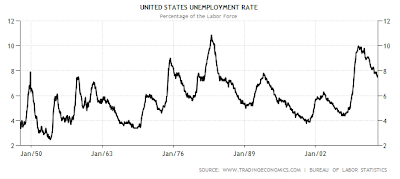 |
| Using real-time unemployment and labor market data to animate a kinetic sculpture. |
Unemployment rates since 2008 have been and continue to be very high. But if you study a chart of unemployment data gathered by the U.S. Bureau of Labor Statistics since 1948, history shows that “business cycles” (recessions and recoveries) have occurred every 10-15 years. The most recent recession was particularly severe, and the ongoing recovery period is markedly slow and painful. But this is not the first time we’ve suffered through a recession, nor will it be the last.
 |
| Fluctuating unemployment rates, 1948-present |
While the unemployment rate has constantly fluctuated between as low as 3% and as high as 10% over the course of time, the labor market is actually much more dynamic than these numbers suggest. Hundreds of thousands of people are either losing or acquiring jobs every month, and new people are continually entering the labor force. The U.S. economy must add $150,000 jobs every month just to keep the unemployment rate stable. And the unemployment rate doesn’t include people who are disabled, involuntarily working part-time, or who have lost hope and stopped looking for a job.
 |
| Push button toy (inspiration for the sculpture's kinetic mechanism) |
My goal is to humanize these statistics by using them to animate an object we typically associate with employment and success: a ladder. The ladder will be cut it into pieces that will be drilled and threaded with steel cable, and then reconstructed to function much like a push-button toy. The tension of the cable, and the subsequent position of the ladder, will be controlled by a motorized winch. A computer will collect real-time unemployment data from the web and use a microcontroller to activate the winch. If the unemployment rate rises, the winch will unwind the cable, and the extra slack will allow the ladder to begin to slouch over. As the unemployment rates drop, the winch will wind the cable back up, and the increased tension will pull the ladder into a more erect position. The ladder will become a kind of body, the rungs like its vertebrae, and the numbers will bring it to life.





No comments:
Post a Comment